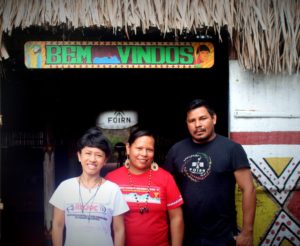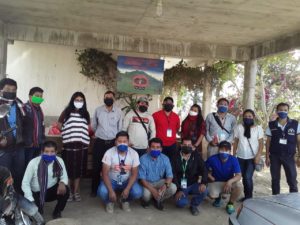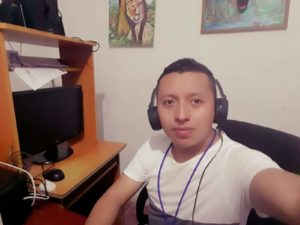More than fifteen days had passed since the Rede Wayuri indigenous media had received an international recognition, but many of its communicators were unaware of its happening. "It has been raining a lot in the last few days, so we have no internet signal and the radio is very staticky. When that happens, we can't talk," explained the radio host and professor Claudia Ferraz, 33, who is of the Wanano people and is the network's coordinator.
In June, the NGO Reporters Without Borders (RSF) included the group in a list to recognize journalists and news outlets for their reliable and vital coverage during the the pandemic.
This goes to show how difficult communication is in the Rio Negro region, where the Wayuri listeners and correspondents are located, spread across 750 indigenous communities in the Brazilian state of Amazonas. Created in 2017, the group produces news bulletins that are broadcast live via radio communication to the villages and distributed via WhatsApp, social networks and other applications.
The headquarters is in the municipality of São Gabriel da Cachoeira, known for being the most indegenous city in Brazil, on the border with Colombia and Venezuela.
With the coronavirus pandemic, the Wayuri Network and other indigenous media in Latin America needed to use their creativity and intensify their efforts to be able to get information about COVID-19 to isolated communities, with little or no access to the internet.

Claudia Ferraz with other communicators from Rede Wayuri, at FOIRN headquarters, where they record their news bulletins. Photo: Disclosure / FOIRN
The LatAm Journalism Review spoke with the Wayuri Network and with indigenous community radio stations in El Salvador, Costa Rica and Guatemala to find out how they are reporting on the coronavirus in their territories. Many of these radio stations survive on donations, broadcast in indigenous languages and are driven by the dedication of volunteer broadcasters, who understand the importance of being the only source of information in communities, especially during a public health crisis.
The coronavirus arrived in São Gabriel da Cachoeira, accessible only by boat and plane, in April. With about 45,000 inhabitants, the municipality does not have ICU beds and only had six respirators, a worrying scenario for the 23 different indigenous communities that live in that region - whose size is comparable to that of England.
Despite a lockdown and curfew, the virus spread quickly and by June 16 was present in at least 70 percent of the indigenous territory of Rio Negro, according to information from the Instituto Socioambiental (ISA). In early July, the municipality had 2,820 confirmed cases and 45 deaths, according to the newspaper A Crítica.
The situation of the pandemic among Brazilian indigenous people is worsened due to precarious social and economic conditions, in addition to greater difficulty in accessing health services, points out ISA. The Federal Public Ministry (MPF) warned in April of the coronavirus represented a "risk of genocide of indigenous peoples" and recommended a series of emergency measures.
According to the American NGO Cultural Survival, which works to defend indigenous rights, cultures and languages in several countries around the world, there is a lot of underreporting of cases in these communities in Latin America and some of them are at risk of extinction.
“The indigenous population is the most susceptible to coronavirus in Latin America. In many areas, even in the deep forest, the pandemic is decimating the indigenous communities because they are the perfect target of the COVID-19 due to no defenses against disease and the negligence of the State, which historically keeps this population vulnerable,” the NGO's Community Media Program told LJR by email.

Sound car from the Rede Wayuri, in São Gabriel da Cachoeira, carries information about Covid-19. Photo: ISA / Personal archive
Faced with this scenario, the Rede Wayuri communicators mobilized to help prevent the spread of the disease, even before the coronavirus arrived in the municipality. In April, they rented a sound car, in partnership with ISA and other entities, to drive around the city, with messages in Portuguese and in indigenous languages about protective measures.
"We were driving with a health professional inside the sound car and an interpreter in indigenous languages. We also used recorded audio," Ferraz told LJR. The campaign lasted two months, until the end of June.
"Now we stopped, because everyone who went in the sound car ended up sick [even while wearing a mask]", she says adding that everyone is well and almost recovered. "We intend to continue this, because there is still a high rate of people with the disease here".
The sound cars were an emergency measure adopted by the Rede Wayuri, but the main form of action of the group of 20 communicators is their news bulletins. The network does not have a radio station, with a defined AM or FM frequency. The bulletins are transmitted live by radio communication equipment, in which one speaks and the other responds.
"We set a day and time with community leaders, they mobilize everyone. When we go in to speak, they are all together to listen to us," explains Ferraz. As in many communities there is no cell phone or internet signal, radio also works as a telephone. "We share the time with people who want to send messages to a 'parente' [relative]", she says.
"Parente" is how indigenous people refer to each other in Brazil - the term is more linked to relationships of affection and belonging than to blood ties, explained Letícia Leite to LJR. The journalist works with advisory and communication training for indigenous leaders at ISA, in addition to being the creator and presenter of Copiô, Parente, a podcast made for forest peoples in Brazil.

Claudia Ferraz, broadcasting the Rede Wayuri news bulletin, via radio communication. Photo: Personal Archive
Communications from the Rede Wayuri are made in Portuguese and in the four most spoken indigenous languages of the 23 that exist in the region: Tukano, Baniwa, Yanomami and Nheengatu.
The communicators, who work as correspondents in their communities, are volunteers and belong to the ethnic groups Baré, Baniwa, Desana, Tariana, Tukano, Tuyuka, Wanano, Yanomami, Piratapuia and Hupdah.
"If we spoke only in Portuguese, it would not reach much of the public, because there are few who understand it. And also our communicators feel much more confident and calm speaking in their own language", says Ferraz.
During the pandemic, Rede Wayuri made several special news bulletins, inviting health professionals from the region to answer questions from the communities. They also launched a series, Leadership voices of Rio Negro in the COVID-19 pandemic, in which indigenous leaders talked about the disease. They asked people to stay in the communities and not go to São Gabriel da Cachoeira, where they were at risk of contracting the coronavirus and, on their return, infecting the rest of the village.
"The city is dangerous for the transmission of the disease. 'Parentes', let's stay home," repeated Ferraz, in her news bulletins. She also advised the population not to collect social benefits in the urban area, but to wait for the authorities to take basic food baskets to the communities.
The Rede Wayuri is a project of the Federation of Indigenous Organizations of Rio Negro, with financial support, advice and training from ISA. For Leite, from the institute, the work of Rede has been fundamental in the public health crisis.
"The news bulletin is the only periodic product of information in this city. In this time of the pandemic, when information actually saves lives, the work of these indigenous people to produce verified information, with journalism techniques, in the voice of these people and in indigenous languages, is central to these regions that are isolated from the point of view of access to journalism. It is these community journalism networks that are making a difference at this moment,” said Leite.
For these reasons the NGO Reporters Without Border gave homage to this network in June. "This made me very happy, because it shows that the Rede Wayuri is being recognized. People here, who know the reality, know that it is not easy. It is a very large region, and until we reach the community there are many challenges and obstacles, hiking, rocks, waterfalls, it is a great sacrifice to take this information there", she said.
Community radio stations: El Salvador, Guatemala and Costa Rica
In San Ildefonso Ixtahuacán, Guatemala, the biggest challenge for the radio announcer Antonio Perez, who is Maya-Mam, was to convince his people that COVID-19 was real. "For the indigenous population, this disease does not exist, it is provoked. And there were people who did not want to obey government decisions," said Perez to LJR.
Perez is one of the directors of the indigenous community radio Nan Pi’x, part of the Asociación Comunitaria de Desarrollo Integral Maya-Mam (ACODIM-M). He also coordinates the 22 radio announcers. "Everything is voluntary, because we don't have funds to pay people," said Perez, who is 57 and is retired from the legal sector.

Radio announcers of the indigenous community radio Nan Pi’x, from Guatemala, wearing masks to protect themselves from the pandemic. Photo: Personal archive
As soon as the pandemic started, Perez gathered the volunteers and distributed masks and alcohol gels so they could work. He also advised them to be well informed about COVID-19 and to pass the prevention guidelines throughout the radio program, which runs from 6 a.m. to 6 p.m.
Perez says he received complaints from listeners, who did not want to know about the disease. An aggravating factor, he said, was that a local TV channel insisted that COVID-19 was not real.
"What we have done is to inform the listeners that the disease is here to stay and that the vaccine will take time. The only thing we have to do is take care of ourselves", he said.
To help the listeners understand what the pandemic is, Perez makes references to stories from the Maya-Mam oral tradition, from past epidemics, to convey the message that it is necessary to prevent the disease from spreading. The radio, which transmits by frequency 97.7. FM and the internet, also helps get the word out about community markets, which were initiated by community members during the pandemic.
"Community markets were created in the towns, so that people do not have to go to the urban center and can avoid agglomeration", he said. According to Perez, the only confirmed COVID-19 cases in the municipality were of residents who came from the United States - Guatemala had 23,972 confirmed cases and 981 deaths by July 7, according to Johns Hopkins University.
The radio, made up entirely of indigenous people, broadcasts to 300,000 inhabitants in 11 municipalities, in the departments of Huehuetenango and San Marcos. Broadcasts are made in Spanish and Mam. "The radio was created in 2007 and is maintained with advertisements for the area's trade. This pays for electricity and equipment maintenance", he explained.

Headquarters of the indigenous community radio La Voz de Talamanca 88.3 FM, in rural Costa Rica. Photo: Disclosure
Radio La Voz de Talamanca, located in Amubri de Talamanca, Costa Rica, uses daily podcasts from the Ministry of Health and talks with its listeners to help spread prevention measures, such as washing hands, wearing masks and alcohol gels. But one of the main recommendations is not to leave the communities, located in the mountains.
"Here since we are in the countryside, we live very far from each other. In the city is where the contagion is. We pass this information on the radio so that people know that when they leave and return, they can bring the virus and infect us all here,” said announcer Jorge Morales, 60.
By July 5 in Costa Rica, almost 5,000 cases and 19 deaths of COVID-19 had been confirmed, according to the government. The country has seen an increase in cases confirmed in the past few days and has had to step back in its reopening.
Morales has worked as a radio volunteer for 30 years. He is a farmer and plants banana and cocoa, as well as other crops for subsistence. La Voz de Talamanca run by eight indigenous volunteers and broadcasts through the frequency 88.3 FM, as well as over the internet, to 11 thousand inhabitants of the Bribri and Cabécar ethnic groups.
"We use Bribri and Spanish on the radio, because some older people don't understand Spanish well. We also have a lot of information recorded in Cabécar," he told LJR.

Jorge Morales, 60, farmer and radio announcer at Radio Cultural La Voz de Talamanca. Photo: Personal archive
The radio was created in 1979, to help rescue indigenous cultural values, and is supported by donations from communities. According to Morales, their air time is short, 6 hours a day. "It is the time that we can do because the economic resources are not enough to pay the expenses of light and telephone to maintain the radio 24 hours," he said.
The pandemic worsened the economic situation of the media, which also lived on now canceled cultural events. Recently, the radio stations La Voz de Talamanca and Nan Pi’x received support from an emergency fund against COVID-19 from Cultural Survival, part of a program to support community media.
According to the NGO, the funds varied between $1,000 and $2,000 dollars and provided short-term sustainability for these radios, helping pay basic bills.
Another radio outlet that received support was Radio Comunitaria Indígena La Voz de Mi Gente, located in Tacuba, El Salvador. The radio, maintained by donations and made up of 20 young Náhuatl-pipil indigenous volunteers, is in a delicate financial condition.
"International aid, such as that of Cultural Survival, is very punctual, it is not enough to cover radio expenses for a year. We paid $200 a month to rent the studio and now we owe $1,000, because we have no money because of the pandemic. Nor do we have funds because the government in this country excludes community radio stations from official advertising,” Jose Marcelo Galicia Escobar, director of the radio, told LJR.
Normally, they transmit through the 92.1FM frequency and through social networks to about 32,000 Náhuatl-pipil indigenous people - recently, due to lack of resources, the broadcast via the internet was interrupted.
Galicia, who also works as a freelance journalist, said the radio has been campaigning to raise awareness about preventive measures. The program runs from 5 a.m. until 9 p.m. "We focus on sanitary measures, but people here are very resistant to wearing masks," says Galicia.
He has also been reporting on coronavirus cases in the community. "Just today I went to one of the cemeteries to write a story about a COVID-19 death, there have already been two people killed by the disease here," he said. In early July, the country decided to postpone the second stage of the economic reopening after an increase in cases, when it accounted for 7,267 contagions and 202 deaths, according to CNN.

Marcelo Galicia, director of Radio La Voz de Mi Gente, from El Salvador
According to Galicia, the indigenous population of El Salvador was the most impacted by the economic crisis in the country, after a quarantine of three months.
"On the radio, we are covering this news about how the coronavirus is affecting indigenous populations, who have no money or resources to survive the pandemic. They are poorer than ever, because they cannot leave home and work", he laments.
Galicia explains that the radio's programming is in Spanish, but there are classes in Náhuatl to help recover the native language, for which people were persecuted for speaking.
He believes that the work of La Voz de Mi Gente has contributed to curb the spread of coronavirus in the region. "It has made a difference. It is very difficult, because we have nothing, not even to pay for the internet, but we do it so that people can know what is happening in the community. There is no other way to do that."